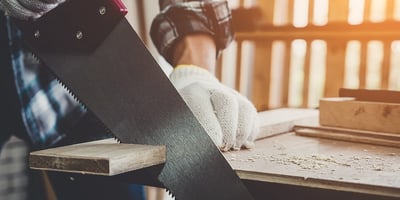Wooden furniture is eco-friendly and energy-efficient. It's also biodegradable and durable, long-lasting when properly constructed, and it's a better insulator than many other materials. All these features have made wooden furniture in high demand. In fact, the global wooden furniture market is expected to grow in the coming years, from $105.9 billion in 2023 to $133.8 billion in 2027.
For carpenters focused on crafting durable wooden furniture, BECK’s Lignoloc® Wooden Nail System stands out. Tailored to work seamlessly with Lignoloc® wooden nails, these nails are crafted from renewable beech wood, ensuring both ecologically sustainable and aesthetic appeal. This makes them an ideal choice for constructing wooden furniture that is not only environmentally friendly but also showcases natural beauty.
Want to learn additional ways to create stronger furniture? Read on!
Choose the Right Wood
We all know that there are many types of wood to work with when making furniture. For some carpenters, the decision to work with one type of wood or another may be an aesthetic decision. However, it's important to keep in mind that hardwoods and softwoods ultimately serve different functions and cannot be used interchangeably. It's best to choose the wood that is most compatible with your project.
Hardwoods are strong and capable of withstanding years of wear and tear. Hardwoods can be used to support weight and pressure without warping. Softwoods are easy to work with, lightweight, and can be easily scratched. These two types of wood have different applications and should be used in different parts of the furniture-making process.
When building a desk, for example, it's important to put a hardwood on the exterior to build the desk's structure. Choose a hardwood that is structurally stable and less likely to warp or pull itself apart over time, like mahogany or walnut. For the interior components of a desk (drawers), use a softwood. Softwoods like pine and poplar are lightweight, easier to work with during construction, and easier for the user to slide open and close.
Make Joints Square and Strong
There are many ways to make joints when building furniture, and choosing the correct method is important.
Countersunk Screws
Countersunk screws are a standard way to attach two pieces of wood. When inserting screws from the outside, pre-drilled holes can prevent wood pieces from splitting. Countersinking is important because it gives more stability to the screw, prevents the hardware from splitting the board, and allows for a smoother surface that is less likely to cause injury or tear clothing.
Dado Joint
Dado joints are made when a channel is cut into one board, so the other board can fit inside it, creating a kind of jigsaw puzzle. Dado joints are strong and allow the furniture maker to use glue more effectively if glue is desired.
Dowels
A dowel is a hidden peg that holds two pieces of furniture together. Dowels can hold together two pieces of wood for a strong, stable joint.
Wooden Nails
Strong wooden nails offer strength and stability for furniture makers, joining wood pieces without introducing metal nails or screws. BECK's Lignoloc® Wooden Nail System includes a coil nailer designed specifically for Lignoloc® wooden nails. Lignoloc® provides builders with the first ever pneumatically driven wooden nail. The nails are available with and without a head, to give you the flexibility you need to use Lignoloc® nails in a variety of applications.
Building Strength with BECK
In summary, crafting strong wooden furniture is essential, given the rising demand for durable and eco-friendly pieces. BECK's Lignoloc® Wooden Nail System, crafted from renewable beech wood, emerges as a key player in fortifying furniture strength while maintaining sustainability and aesthetics. Whether constructing desks or chairs, the synergy of quality wood choices and advanced joint solutions, particularly with BECK, sets the foundation for exceptionally sturdy and visually appealing wooden furniture.
Interested in the LignoLoc® Wooden Nail System? Check it out below!
.svg.png)


